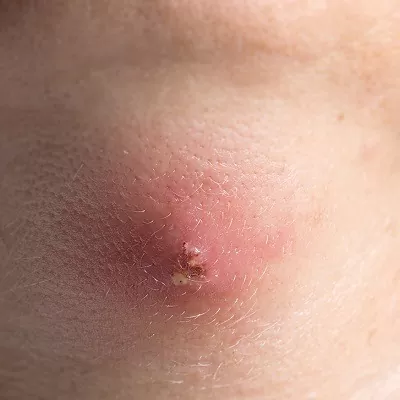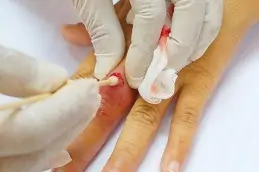What is Abscess Drainage?
Drainage of abscesses of different localization is a minimally invasive and less traumatic operation, which consists of the introduction of a special tube for drainage into the abscess cavity. Such an intervention allows you to evacuate the purulent contents and rinse the cavity with antiseptic solutions.
Results:
Puncture and drainage treatment of Incision and Drainage of Abscesses of various localization is a modern, minimally invasive method with high efficiency and low complication rate. Such interventions allow patients to quickly return to their usual way of life and avoid extensive surgical intervention.
The main conditions for successful minimally invasive treatment are the presence of safe access, adequate sanitation of the purulent focus and regular washing of the abscess cavity with antiseptic solutions.
Who is a Candidate?
- Abscesses of the abdominal cavity of various localization after previous operations
- Appendicular abscess
- Retroperitoneal abscesses in pancreatic necrosis, etc.
With an extensive lesion, it is possible to install several drainages with the formation of a drainage-flushing system.
Causes of Occurrence and Development:
The leading cause of an abscess is a bacterial infection trapped in the tissues from the surrounding world. Bacteria enter the body due to microtraumas that violate the integrity of the skin. Such injuries include cuts and minor abrasions, scratches, damages resulting from shaving or hair treatments, manicure or pedicure, and others. At the same time, in the case of dirt or small particles in the form of a splinter, the likelihood of the formation of a purulent accumulation increases.
The appearance of an accumulation of pus can occur for other reasons of an abscess:
- Migration of infection from the primary focus of infection
- Suppurating hematomas and cysts
- Surgical manipulations – violation of sanitary rules in the form of non-sterile devices
- Violations in the administration of drugs and drugs, for example, impaired concentration during vaccinations.
The abscess develops further under the influence of reduced immunity or circulatory disorders in the abscess.
Stages of the Procedure:
The operation is performed in a specially equipped operating room under ultrasound and X-ray control. As a rule, this Incision and Drainage of Abscesses Georgia & Tbilisi is performed under local anaesthesia and does not require anaesthesia.
- Before starting the operation, the patient undergoes an ultrasound examination, and the site of the future puncture is selected, the location of adjacent organs and large vessels is assessed.
- Next, local anesthesia is performed. After that, the puncture of the abscess cavity is performed. When it hits the desired place, pus begins to flow through the needle. A contrast agent is injected into the cavity to assess the shape and streaks and decide on installing another drainage.
- Under X-ray control, a special guidewire with a soft tip is inserted into the abscess cavity, which allows the needle to be removed.
- The next step is to expand the puncture canal to the required diameter. After that, drainage is installed along the string into the abscess cavity, and the string is removed. The tube is additionally fixed to the skin. The contents are evacuated and sent for bacteriological examination, and the cavity is washed with antiseptic solutions.
After the Treatment:
The wound heals in 24-48 hours. The exceptions are some small abscesses, such as paronychia or small boils, which do not need close monitoring.
- Drainage relieves most of the pain from abscesses, but postoperative pain relievers may be needed.
- Instruct the patient to lift the wound and not disturb the dressing and splint until the first follow-up visit.
- Any tampon can be removed once there is healthy granulation tissue throughout the cavity and there is no longer any drainage. Ask the patient to initiate warm baths and gentle hydrostatic debridement at home. Continue changing dressings every 1-2 days and continue follow-up visits as needed until complete healing.
- Patients should be re-evaluated if they have worsening pain, increased drainage, or spread of erythema.
Incision And Drainage Of Abscesses FAQ’s:
When Does Abscess Need Incision And Drainage?
If an abscess is large, not responding to antibiotics, causing severe symptoms, or exhibiting systemic signs, incision and drainage are required. The choice is based on various factors, including the patient's general health, location, and size. A sterile environment and a healthcare professional alone should perform this procedure. If you suspect an abscess, don't try self-drainage at home and get medical help right away.
What Is The Drainage Technique For Abscess?
An accumulation of infected bodily fluid is called an abscess. Using imaging guidance, a needle or catheter is inserted through the skin into the abscess to remove or drain the infected fluid in percutaneous abscess drainage. The recovery process is quicker than with open surgical drainage.
Is Abscess Drainage A Major Surgery?
While most abscesses require a general anesthetic, a small abscess can be drained under local anesthesia. Usually, the procedure takes ten to twenty minutes. Over the abscess, your surgeon will make a cut in your skin. This permits the pus to escape.
What Are The Risks Of Incision And Drainage Of Abscess?
After surgery, there is a tiny possibility of bleeding and bruises. It is possible for there to be a superficial wound infection and additional abscess formation, in which case more washout and debridement or an antibiotic course may be required.
How Long Does An Abscess Take To Heal After Incision And Drainage?
Antibiotics may be prescribed to you; follow the directions on the label. You can take over-the-counter painkillers as needed if you need pain relief. It will take a week or two for your wound to heal and seal. When you're cleared to resume work, your doctor will let you know.
What To Expect After Abscess Drainage?
Throughout the first 24 hours following the procedure, a slight fever is typical. The drainage bag and catheter will likely stay in place for a few days. Make sure to comply with any guidance provided to you regarding the maintenance of the catheter and drainage site.
Book a Free Appointment
If you would like to perform an Incision and Drainage of Abscesses in Georgia & Tbilisi, visit the Sydney Royal Clinic. We offer this first-class treatment at an affordable price, so hurry up and don’t miss the chance. Fill out the consultation form to schedule a free meeting with our representatives.





